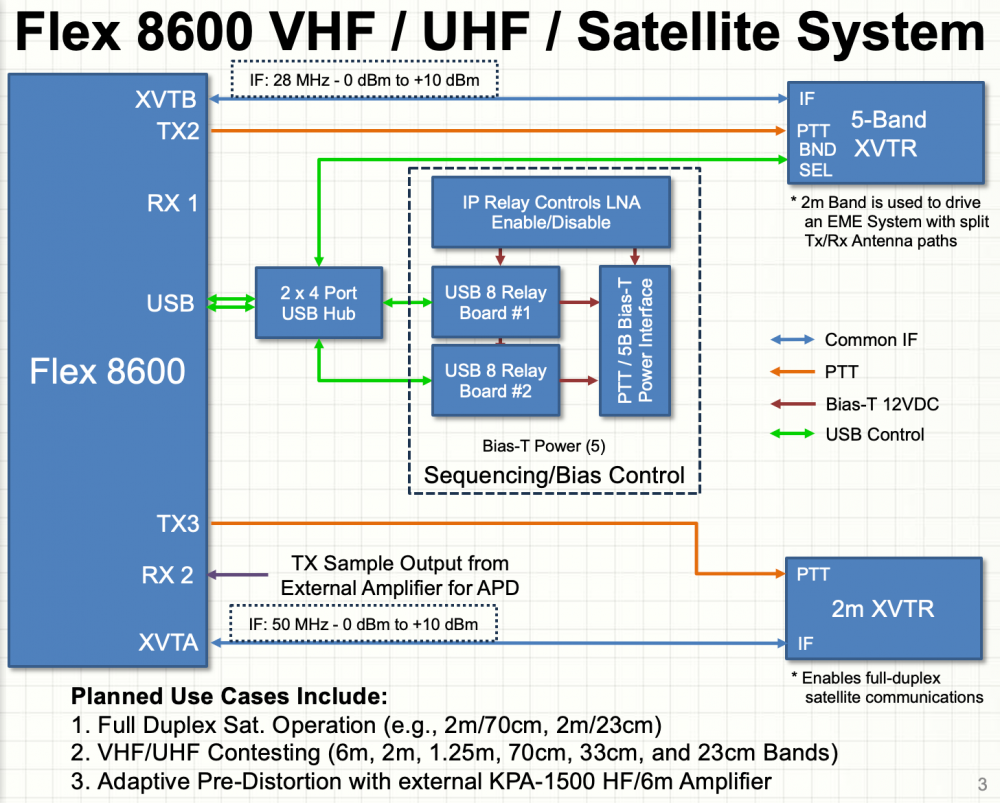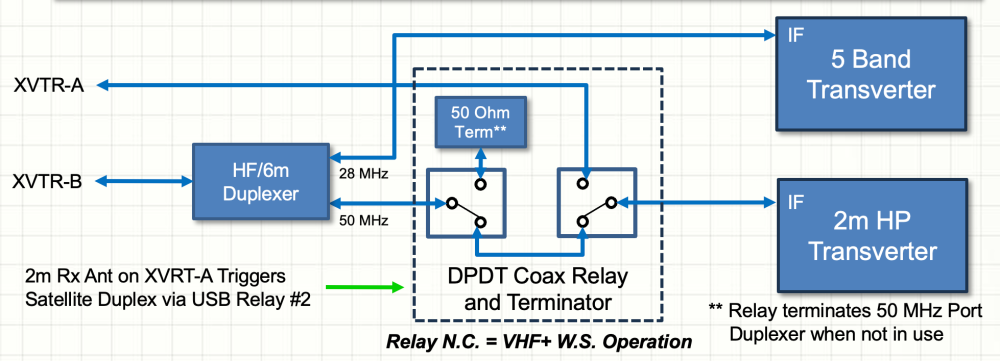SmartSDR v4.1.3 | SmartSDR v4.1.3 Release Notes
SmartSDR v3.10.15 | SmartSDR v3.10.15 Release Notes
The latest 4O3A Genius Product Software and Firmware
Need technical support from FlexRadio? It's as simple as Creating a HelpDesk ticket.
Application questions for new 8600 with two Transverters
I have a new 8600 on the way, and I am working with Corey at Q5 Signal on a plan for Transverters for my new setup. The following is my current architecture -
The transverters will be from Q5 Signal. Here's what I am planning to use -
We are using two Transverters to enable full-duplex operation with Satellites. I also have a 2m EME system with separate Tx and Rx antenna paths, and the plan is to use the 2m port on the 5-Band Transverter to drive that system.
The 8600 will be for the Tx drive only in the EME application. I am using a phase-coherent dual receive system for LinkRF to enable adaptive polarity on the receive side. Perhaps we will see support for adaptive polarity on the SmartSDR platform in the future.
A combination of USB-controlled relays, MicroBit WebSwitch IP-controlled relays, and Bias-T devices is used to control and sequence coaxial-powered LNAs and transverters. I plan to use the USB Cable control system in SmartSDR to arrange proper timing to sequence everything.
First, does anyone here have any comments or suggestions to improve this approach?
Corey and I are also discussing the possibility of using a single XVTR port on the 8600 along with a 28 MHz / 50 MHz diplexer to split and feed IF to/from both Transverters from a single XVTR port on the 8600. I could use some help in determining if this scenario is supported by the combination of the 8600 and SmartSDR. My questions include:
- Can SmartSDR configure the 8600 to have two different transverters with different IF frequencies on the same XVTR output?
- If the answer is yes, will a pair of transverters configured this way be able to operate in a full-duplex configuration for Satellite use (ie, receiving on both transverters simultaneously or transmitting on one while receiving on the other simultaneously)?
I suspect that this arrangement will not work, as it appears that the 8600 would need to utilize both SCUs to enable full-duplex operation. If it did work, it would be great to save the port on the 8600 for a future application.
All comments and suggestions are appreciated!
Fred, AB1OC
Best Answer
-
Hi Fred
Corey and I are also discussing the possibility of using a single XVTR port on the 8600 along with a 28 MHz / 50 MHz diplexer to split and feed IF to/from both Transverters from a single XVTR port on the 8600. I could use some help in determining if this scenario is supported by the combination of the 8600 and SmartSDR. My questions include:
Can SmartSDR configure the 8600 to have two different transverters with different IF frequencies on the same XVTR output?
If the answer is yes, will a pair of transverters configured this way be able to operate in a full-duplex configuration for Satellite use (ie, receiving on both transverters simultaneously or transmitting on one while receiving on the other simultaneously)?
You can do dual IF on the same transverter port (I do it with a simple diplexor), so, yes, you can do that. But, no, you can't do full duplex on the same transverter port. As you surmised, you do need to use both SCUs. I have my UHF on 28Mhz and my 1296 transverter on 50Mhz.
I think your layout is pretty good and making good use of the USB relays/triggers, you should be fine.
Hopefully that helps a bit.
1
Answers
-
Thank you, Mike, I appreciate your help!
Fred, AB1OC
0 -
At the recommendation of Q5 Signal, I am planning to configure the 2m Transverter on XVTR-A for a 50 MHz IF to improve isolation between the two Transverters. The 5 Band Transverter will be configured for a 28 MHz IF.
A follow-up question related to my planned configuration. Is it possible to receive on 6m, 2m, and a third band (one of 1.25m, 70cm, 33cm, or 23cm) simultaneously with this setup? What will happen to the Rx paths if we transmit on one of the three active Rx bands?
There are enough antenna paths, I think, so the question is whether I can create two slices on a single SCU to receive on two different bands simultaneously.
Also, does my choice of 50 MHz for the 2m IF have any implications for receiving on three bands simultaneously, or for transmitting on one of the 6m or the 2m High Power (50 MHZ IF) transverter while listening to Rx on the other band? An example would be to transmit on 6m via Ant1, while listening to 2m on the HP Transverter and 70cm on the 5-Band Transverter.
0 -
Here is a copy of my updated configuration for reference.
0 -
I created a mock-up of my planned configuration using the new 8600 here, and it appears that this setup will support a maximum of 2 bands at once. As long as each band uses a separate SCU, the combination works fine. If I bring a third pan adapter up and create a slice on a third band, it appears that any changes to the antenna/xvtr/rx connections of one of the slice receivers is applied to all of the other slices on that SCU.
Would it be possible to use a 28 MHz/50 MHz diplexer with my two transverters and a single XVTR input to allow them to both operate on the same SCU simultaneously?
0 -
Hi Fred
I have 1 transverter (144) on 28Mhz on XVTA connected to TX1.
I have a 2nd transverter (440) on 28Mhz on XVTB connected to a diPlexor (hi/low split around 40Mhz) with the RF coming from the low side and TX2 for PTT.
I have a 3rd transverter (1296) on 50Mhz on XVTB connected to the same diPlexor with the RF coming from the Hi side and TX3 for PTT.
Using this method, the RF from both on XVTB are 100% rf isolated.
Now, I can bring up 3 or even 4 panadapters for what ever band I choose and I just make sure that I use use the correct transverter port (XVTA or XVTB).
I theory, you could use up to 4 transverter easily but you might find it easier to use an USB Relay Board to supply your PTT for the 4th transverter.
You are correct on your comment, but that is ok. That is what you want.
73, Mike
0 -
Thank you, Mike. I like to be able to monitor several bands in VHF+ contests so the diplexor approach will work out well for me.
0 -
Hi Mike. One final question/thought. I am guessing that for the case where two transverters share a given XCTR output on the 8600 via a diplexer, when one of the pair goes into Tx, the other one's receive is disconnected. Is that right, or is it possible for the second transverter to continue receiving when the first one in the pair is in transmit mode?
0 -
When it does into TX on 440 for example, the 28Mhz signal is sent to the Transverter with the 28Mhz IF. The signal can't get to the other 50Mhz IF transverter because it is blocked by the diplexor. And, correct, you can't listen to the 50Mhz IF Transverter at that time.
You cannot receive and transmit at the same time on the same antenna port. It is one of the limitations.
0 -
Thanks, Mike; that's what I thought. I appreciate you taking the time to discuss this with me - I'm getting a much better understanding of the SDR's architecture as a result. I'm going to make one last attempt at having my cake and eating it too. I'm adding a relay to reconfigure the structure of the IF connections to enable two separate use cases:
- Full-duplex satellite operation on the 2m band and an additional band (ex, 70 cm)
- A configuration that is not full duplex but enables operation on 6m, 2m, and one additional band between 1.25m and 23cm for VHF+ contesting
Here's my solution -
The Coax relay I added reconfigures the IF connection for the 2m HP Transverter to bypass the Duplexer and utilize the XVTR-A connection to the radio for full-duplex satellite operation. I use a pole of the relay to terminate the unused 50 MHz Duplexer port in this configuration, thereby avoiding any impact on the Duplexer's performance.
With the relay disengaged, both transverters share the same XVTR port and SCU, allowing operation of both Transverters on two different bands. In this configuration, Tx on either Transverter disconnects the other one. This is my VHF+ contesting setup.
Finally, I believe I can trigger the coax relay with the following BITS cable (relay) configuration -
The rule detects that the 2m Transverter has been configured for full-duplex satellite operation and energizes the coax relay to connect the 2m Transverter to the second Transverter port (XVTR-A) on the 8600. This also terminates the 50 MHz Duplexer port.
Mike, could you please review this one last time and let me know if I've missed anything? I would appreciate it.
Additionally, I am a bit unclear about how the PTT Off button and the PTT and Tx delays in the BITS cables function. What is the effect of turning on the "PTT Off" option? Does it make the rule conditional on the radio entering transmission mode? Also, precisely what do the delays do?. Finally, can the delays be used to configure PTT and Tx delays when the PTT Off button is not engaged? What I am looking for here is some clarity on how this last group of options works, how they relate to the rule that triggers the BITS cable, and some guidance on how to apply them correctly. I've reviewed the USB cables document, but I still don't have a clear understanding.
Sorry for the length of this thread. I hope that all of this is helpful to others in the forums.
Fred, AB1OC
0 -
One final note. I am planning to use a combination of Transmit and General Profiles to configure these use cases. Assuming my basic design is good, I can post the prototypes of the Profiles here for comment and to help others.
Fred, AB1OC
0
Leave a Comment
Categories
- All Categories
- 377 Community Topics
- 2.1K New Ideas
- 630 The Flea Market
- 8.2K Software
- 115 SmartSDR+
- 6.4K SmartSDR for Windows
- 183 SmartSDR for Maestro and M models
- 428 SmartSDR for Mac
- 271 SmartSDR for iOS
- 258 SmartSDR CAT
- 191 DAX
- 382 SmartSDR API
- 9.3K Radios and Accessories
- 36 Aurora
- 253 FLEX-8000 Signature Series
- 7.2K FLEX-6000 Signature Series
- 945 Maestro
- 55 FlexControl
- 865 FLEX Series (Legacy) Radios
- 922 Genius Products
- 462 Power Genius XL Amplifier
- 336 Tuner Genius XL
- 124 Antenna Genius
- 296 Shack Infrastructure
- 208 Networking
- 457 Remote Operation (SmartLink)
- 144 Contesting
- 787 Peripherals & Station Integration
- 139 Amateur Radio Interests
- 1K Third-Party Software






